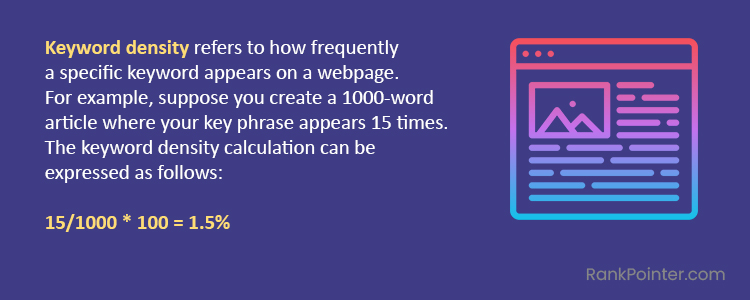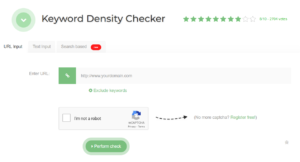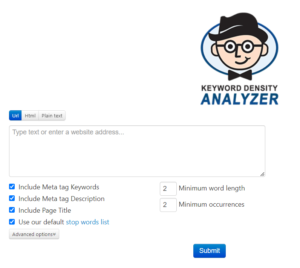Keyword density staWhy nds as an important metric in the case of SEO. Understanding its essence and significance is crucial for developing content that ranks well on search engine results pages. This comprehensive guide explains the concept of keyword density, its relevance in SEO strategies, methodologies to calculate it, best practices, and tools to streamline the process.
What Is Keyword Density in SEO?
Keyword density, also known as keyword frequency, denotes the ratio of a specific keyword’s occurrences to the total word count on a webpage.
Typically expressed as a percentage or ratio, higher keyword density implies increased prominence of the chosen keyword within the content.
Importance of Keyword Density in SEO
Keywords are critical part of search engine optimization strategies, alongside relevant content and optimized website design.
Ranking for the right keywords enhances visibility, setting websites apart and propelling them towards the top of SERPs.
However, keyword stuffing, the act of excessively cramming keywords into content, is a disapproved practice that can lead to severe penalties, including removal from SERPs.
Monitoring keyword density ensures that keywords are utilized optimally without compromising the integrity of the content or risking penalization from search engines due to unethical practices like keyword stuffing.
How to Calculate Keyword Density?
One can manually calculate keyword density using the formula:
Keyword Density = (Number of Keywords / Total Number of Words) × 100
Alternatively, numerous online tools accelerate the process, offering hassle-free analysis of keyword density within content.

Keyword Density Best Practices
1. Never Aim for Specific Keyword Density
Strive to avoid targeting specific keyword densities. Google no longer prioritizes keyword density as a ranking factor, and aiming for a particular density can lead to adverse effects.
Keyword stuffing, or artificially inflating keyword usage, is disapproved by Google as it compromises user experience. Instead, prioritize natural writing that incorporates keywords organically.
2. Focus on Topic Coverage Instead
Google may not look at keyword density anymore, but it does evaluate topic coverage. Instead of adding your target keyword repeatedly, concentrate on covering the topic comprehensively.
This involves including subtopics that align with user expectations. To gather ideas for subtopics, analyze top-ranking pages for your target keyword and identify common subheadings.
3. Include Keywords in Key Places
While avoiding keyword stuffing, strategically place your main keyword in prominent areas such as the title tag, H1 heading, URL, and meta description.
However, ensure that keyword inclusion feels natural and enhances the overall readability of the content. Avoid forcing keywords into these elements and prioritize relevance and user experience.
Additionally, consider utilizing close variations of the keyword when appropriate to maintain a natural flow of language.
Keyword Density Checkers
Check out the major keyword density tools.
1. SEO Review Tools Keyword Density Checker
This browser-based tool allows you to input your site URL or page text, completing a simple captcha to perform a keyword density check. While lacking in-depth analytics, it provides an overview of current keyword density.
Additionally, it features a color warning system for keywords appearing excessively and offers a breakdown by word-number, allowing exclusion of specific phrases.

2. SEOBook Keyword Density Analyzer
Similar to the previous tool, this free option requires an account but offers basic keyword density reports. It enables users to search for a target keyword in Google, retrieve data for top-ranked pages using the same keyword, and analyze keyword usage.
The analyzer allows inclusion of meta information, exclusion of stop words, and setting a minimum word length for refined analysis.

3. Copywritely Keyword Density Checker
Copywritely’s checker displays top keywords by density and color-codes frequently occurring terms. While more limited than other options, it provides a quick, at-a-glance keyword density check.
However, it lacks features such as excluding stop words and including meta descriptions. Nonetheless, its simplicity and user-friendliness make it suitable for beginners.

4. Semrush’s On-Page SEO Checker
Semrush’s comprehensive on-page SEO checker includes a keyword density checker, named “keyword phrase usage,” among its array of tools.
In addition to assessing keyword density, it offers automated SEO checkups, title and metadata assessments, backlink prospecting, and in-depth site analysis.
Although it comes at a premium price, starting at $119.95/month, it provides valuable insights for competitive comparison and industry-standard adherence.

Closing Notes on Keyword Density in SEO
Keyword density remains a pivotal aspect of SEO strategies, influencing content visibility and relevance on SERPs. While avoiding keyword stuffing, focusing on holistic topic coverage, and leveraging strategic keyword placement are important. Utilizing reliable keyword density checkers streamlines the content optimization process.
Frequently Asked Questions
What Is a Good Keyword Density?
Although no fixed rule dictates keyword density, a general guideline suggests approximately 1-2 keywords per 100 words of content, translating to a 1-2% density. However, prioritizing user experience and relevance over keyword density is paramount. Leveraging keyword variants and aligning with user intent enhance content effectiveness without succumbing to outdated practices like keyword stuffing.


